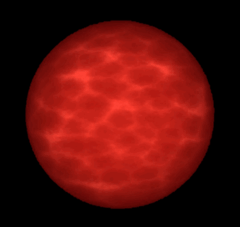DEN 0255−4700
DENIS 0255−4700 is an extremely faint brown dwarf approximately 16 light years from the Solar System in the southern constellation of Eridanus.[1][4] It is the closest isolated L brown dwarf (no undiscovered L dwarves are expected to be closer), and only after the binary Luhman 16. It is also the faintest brown dwarf (with the absolute magnitude of MV=24.44) having measured visible magnitude.[3] A number of nearer T and Y-type dwarfs are known, specifically WISE 0855−0714, Epsilon Indi B and C, SCR 1845-6357 B, DEN 1048−3956, and UPGS 0722−05.
 Artist's impression of an L-dwarf | |
| Observation data Epoch J2000 Equinox J2000 | |
|---|---|
| Constellation | Eridanus |
| Right ascension | 02h 55m 03.579s[1] |
| Declination | −47° 00′ 50.99″[1] |
| Characteristics | |
| Spectral type | L8/L9[2] |
| Apparent magnitude (V) | ~22.9[1] |
| Apparent magnitude (R) | ~20.1[1] |
| Apparent magnitude (I) | ~17.2[1] |
| Apparent magnitude (J) | ~13.2[1] |
| Astrometry | |
| Proper motion (μ) | RA: 1053 ± 11[1] mas/yr Dec.: −547 ± 6[1] mas/yr |
| Parallax (π) | 201.37 ± 3.89[3] mas |
| Distance | 16.2 ± 0.3 ly (4.97 ± 0.10 pc) |
| Absolute magnitude (MV) | 24.44 |
| Details | |
| Mass | 0.025–0.065[2] M☉ |
| Radius | 0.08–0.1[2] R☉ |
| Temperature | ~1300[2] K |
| Age | 0.3–10[2] Gyr |
| Other designations | |
| Database references | |
| SIMBAD | data |
History of observations
DENIS 0255−4700 was identified for the first time as a probable nearby object in 1999.[4] Its proximity to the Solar System was established by the RECONS group in 2006 when its trigonometric parallax was measured.[3] DENIS 0255-4700 has a relatively small tangential velocity of 27.0 ± 0.5 km/s.[2]
Properties
The photospheric temperature of DENIS 0255−4700 is estimated at about 1300 K.[2] Its atmosphere in addition to hydrogen and helium contains water vapor, methane and possibly ammonia.[5] The mass of DENIS 0255−4700 lies in the range from 25 to 65 Jupiter masses corresponding to the age range from 0.3 to 10 billion years.[2]
See also
References
- "2MUCD 10158 – Brown Dwarf (M<0.08 M☉)". Centre de données astronomiques de Strasbourg. Retrieved 2009-12-14.
- Stephens, D. C.; Leggett, S. K.; Cushing, M. C.; Marley, M. S.; Saumon, D.; Geballe, T. R.; Golimowski, D. A.; Fan, X.; Noll, K. S. (2009). "The 0.8–14.5 μm Spectra of Mid-L to Mid-T Dwarfs: Diagnostics of Effective Temperature, Grain Sedimentation, Gas Transport, and Surface Gravity". The Astrophysical Journal. 702 (1): 154–170. arXiv:0906.2991. Bibcode:2009ApJ...702..154S. doi:10.1088/0004-637X/702/1/154.
- Costa, E.; Méndez, R. A.; Jao, W. -C.; Henry, T. J.; Subasavage, J. P.; Ianna, P. A. (2006). "The Solar Neighborhood. XVI. Parallaxes from CTIOPI: Final Results from the 1.5 m Telescope Program". The Astronomical Journal. 132 (3): 1234. Bibcode:2006AJ....132.1234C. CiteSeerX 10.1.1.622.2310. doi:10.1086/505706.
- "Discovery of the Nearest L Dwarf: the Intrinsically Faintest Object at Visual Wavelengths Known Beyond our Solar System". RECONS. Retrieved 2007-06-17.
- Cushing, Michael C. (2006). "Spitzer Space Telescope Observations of M, L, and T Dwarfs". ASP Conference Series. 357: 66–67. Bibcode:2006ASPC..357...66C.